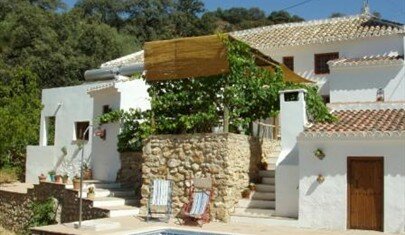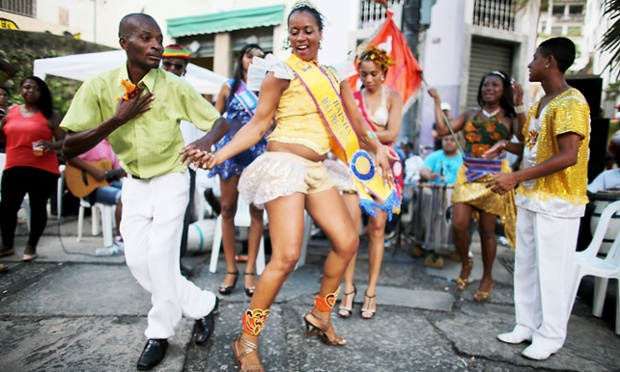
The olive harvest is just around the corner once again…I have been asked by my neighbours/friends to help them harvest the green olives again this year. On a night of our village Fiesta a few weeks ago, Maria Angustias grabbed me and asked, “Clive, are feeling strong like a burro (donkey)? If you are, can you work with us again to do the green olives from the middle of Oct?” I had a feeling that I could not refuse this wonderful offer of employment as our Spanish cookery holiday season starts to slow down. No, it is not like that, they do not treat me like a slave at all, although some farmers treat a Moro or Gitano like a (paid) slave!
Last year, it was the first time I had worked with Maria Angustias and her husband Francisco who between them own a lot of olive land. There was rather a great demand in Spanish green olives as a result of some natural disasters in Greece and there was a shortage of green olives which are more suitable as table olives. In winter, the green olives turn black and they are harvested for oil. And it seems that they can fetch a good price for the green olives again this year. The price of olives fluctuate like the stocks and shares in the financial market. My wife, Maki says, who was an investment banker in the Derivatives Market before moving to Spain to run our cooking holidays, that olives are commodities similar to the Crude Oil ! Now I understand why these olive farmers really like to talk about dinero (money) a lot because they are like Stock Brokers…… maybe not, but they have to be aware of the price sensitivity at all times.
We actually have a lot of good laughs, though in a way we have nothing much in common. On top of that, I do not really speak fluent Spanish, I am ashamed to admit that I have never taken any language lessons. I cannot sit down in a classroom to learn it. I love reading but sitting in a classroom is just not me. But, I have picked up a lot, even my wife Maki who speaks a lot of languages says I am doing quite well. I think she means it, she is always very honest and straight. So, what do we talk about ? Well, initially we talked a lot about the olives as I was very keen to learn every aspect of it. There are about 16 types of olives and generally speaking, 3 of which are commonly grown and harvested here in Andalusia. On our Finca land, we have about 30 olive trees, all of them belong to those 3 species. Some are about 200 years old, some only 10 years old. I have learned also what they feed, how to prune, and how to treat the diseases and insects. It looks so easy, but I will never be able to prune the olive trees successfully like they could, they just know it by heart, it is a work of an artist with a huge chain saw.
The daily work begins at 9am. It is not too early. My son goes off to our village school just before 9, so we say good bye and I am taken to their olive grove near by. First, we lay a very large net, which could be 15m long and 5m wide, on the ground around the tree. Then, if the ground is flat, it is easy, but if not, we have to use pegs and sticks to raise the edge of the net, so that the olives would not escape from the net. They don’t like loosing even one olive, believe it or not ! And with a long wooden or a light fibreglass pole, we gently shake the branches. Francisco may use a motorised shaker and Maria Angustias and I shake the branches very carefully but fast. If we are lucky enough to work on a flat land and if harvesting a relatively mature tree, Francisco may use a large mechanical shaker attached to a tractor. But unfortunately, we do not get to use this very often as our region of Andalusia is quite hilly.
Once all the olives are shaken, we would gather them by moving the net, throwing any unwanted leaves or branches quickly. Then we put them in a soft sack made of natural fibres to protect the olives from getting bruised. If they are bruised, it is bad news. Generally speaking, one mature productive tree could produce 100-200 kg of olive fruits. Obviously the green olives contain less liquid and oil, so they weigh less than the black ones.
I remember when we harvested our own olive trees for the 1st time after years of neglect (as previous owners of our Finca were too old to take care of them), we got about 400 kg of black olives from approximately 20 trees. We did not get much money for them but we felt a strong sense of satisfaction. I am sure the locals were laughing at us foreigners!
About 1pm, we stop for lunch for 1 hour. We all have packed lunch of sandwiches with extra virgin olive oil, jamon, or chorizo, salad, some fruits, dried nuts and some chocolate and cakes. Very basic, but hams and chorizos are all home-made, hence they taste nothing like the ones you buy in the supermarkets.
I sometimes take some hot pumpkin soup or chicken and winter vegetable soup for everybody and they really enjoy it. We then talk about food. The locals eat very basic, good food, always freshly cooked but as far as the menus are concerned, it is very limited. Maria Angustias cooks a gorgeous roast pig or grilled pork chops, seasoned only with salt, she does not even use pepper corns but it is good, home reared pigs, of course.
As a professional chef, I am always looking for interesting local and traditional recipes, some of which are all forgotten by the people of today. With the help of Maki, we often search for some old Spanish recipes that were passed on verbally and we listen and watch the locals preparing them and recreate the recipes for ourselves. For example, a hare is something that is readily available here, and yet people do not know or have forgotten how to cook it. We have an old hare recipe that goes back to the 16th century. For me this is the greatest challenge of all – to rediscover and recreate what is forgotten, and promote the old and the new for the future. I have more pleasure in doing what I am doing now, trying to reach the real people’s heart and soul than to please a Food Critique or to receive an award.
After the topic of food, we may talk about the family and they start gossiping passionately. The other day I have found that the man who is know as El Bonito, who is about 75 years of age has 13 children and 45 grandchildren ! This is where I usually stop listening and have a quiet rest on my own under an olive tree….. unless father of Francisco comes to bring a few beers.
After lunch we resume our work again. We may do a few more trees by 5pm. Between 3 of us, we can clear 10 – 12 trees a day. On average, in 3 days we harvest over 3000kg of olives. That sounds a lot. But there are 200 thousand million registered (for commercial purpose) olive tress in Andalusia alone, no wonder why Spain is the biggest producer of Olive Oil in the world and 75% of Spanish Olive Oil comes from Andalusia. But green olives are not commonly harvested in Spain.
Francisco will then take his olives to the Cooperation of Olives or a private olive mill, depending on the market price. Sometimes he travels far to sell them to the highest bidder and it takes a few hours for him to make a round trip on a tractor.
When I get home about 6pm, after 7 hours of solid manual labour, I am totally exhausted. My little boy jumps up on me and tells me how much he missed me and all the pains and aches are gone. I have a quick shower and have a long conversation with Cei who does not stop asking impossible questions. Maki cooks for us a great dinner of Fusion food, or Japanese food or anything else, always very well balanced, imaginative and full of flavours. She has a variety of her own creations, so I do not have to cook after a hard day at the olive grove…
To experience the olive oil harvest for yourself, why not join Clive and Maki at their amazing 150 year old Finca in the heart of Andalucia for a cookery holiday with a difference. Learn to cook some of Spain’s most delicious food, stay in the Finca, relax by the pool and enjoy their warm hospitality. To see our cooking courses in Andalucia, visit golearnto.com and click on the links now.






 Designed by
Designed by